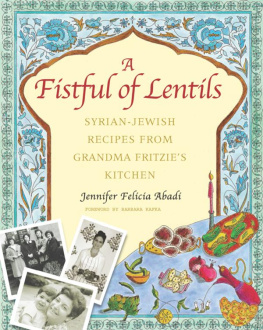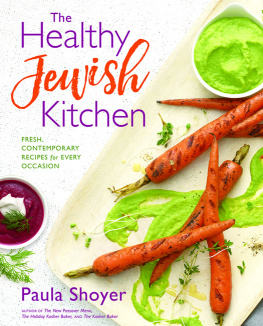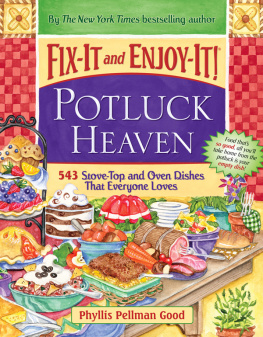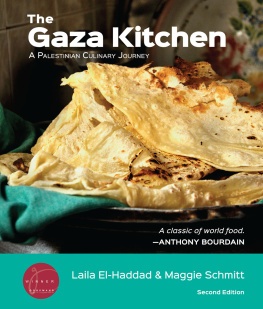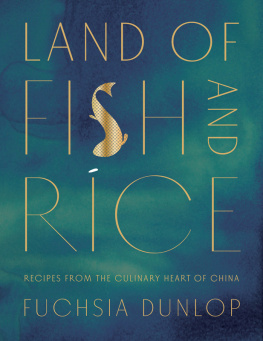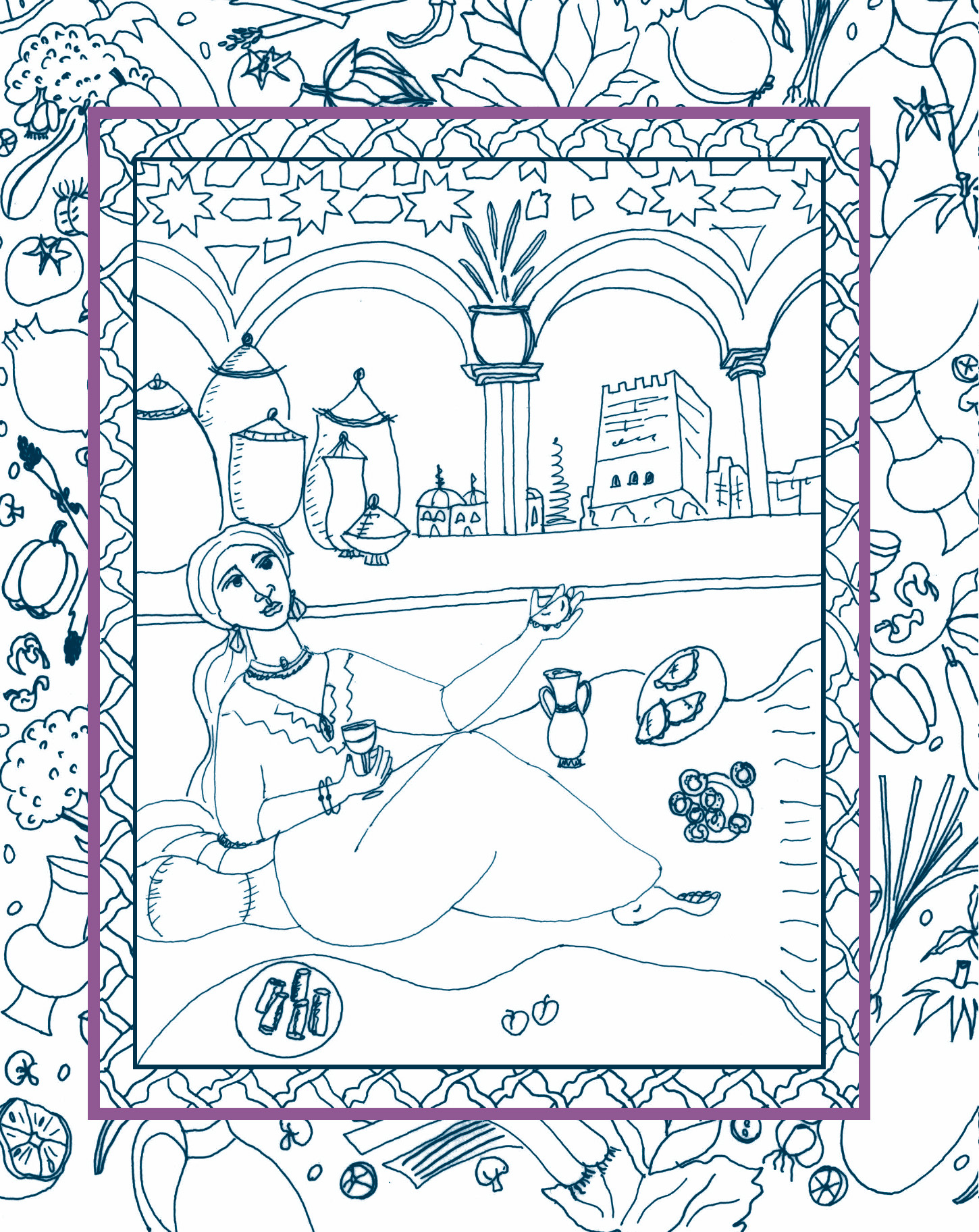
The Harvard Common Press
535 Albany Street
Boston, Massachusetts 02118
Text and illustrations 2002 by Jennifer Felicia Abadi
All rights reserved. No part of this publication may be reproduced or
transmitted in any form or by any means, electronic or mechanical, in
cluding photocopying, recording, or any information storage or retrieval
system, without permission in writing from the publisher.
Printed in the United States of America
Printed on acid-free paper
The Library of Congress has cataloged the hardcover edition as follows:
Abadi, Jennifer Felicia.
A fistful of lentils : Syrian-Jewish recipes from grandma Fritzie's
kitchen / Jennifer Felicia Abadi.
p. cm.
Includes index.
ISBN 1-55832-218-3 (cloth : alk. paper)
1. Cookery, Syrian. 2. Cookery, Jewish. I. Title.
TX725.S9 A25 2002
641.595691dc21
2001047060
ISBN 978-1-55832-219-6
Special bulk-order discounts are available on this and other Harvard
Common Press books. Companies and organizations may purchase
books for premiums or resale, or may arrange a custom edition, by
contacting the Marketing Director at the address above.
10 9 8 7 6 5 4 3 2 1
Book design by Richard Oriolo
Cover design by Night & Day Design
Cover and interior illustrations by Jennifer Felicia Abadi
To Grandma Fritzie, for pushing me to go after what I wanted out of life, for being an artistic inspiration, for talking to me, for laughing with me, for spending time being my friend, for teaching me to be tough yet generous and loving, for telling me to believe that I am beautiful, and, most of all, for being the best grandmother a grandchild could ever have.
To my mother, Annette, for being the first one to record recipes from my great-grandmother Esther, for giving me the idea to write this cookbook, for being my partner spending countless hours writing, editing, and cooking, and for assuring me that somehow, no matter what, this cookbook and personal story would be told. I can only hope to be as supportive, loving, and generous a mother one day as she has always been for me.
In loving memory of my aunt Essie, who worked with my mother thirty years ago collecting the recipes from my great-grandmother, and without whom this book would not have been possible.
To my younger sister, Vanessa, the "Sambussak Queen," who has learned over the years to be a good Syrian cook as well. May she continue the tradition when she has a family of her own one day.
And to the generations of Syrian women who through food were able to find their individual voice while living in a mostly male-dominated culture. May this cookbook serve as a tribute to all of you for your continuous dedication and loving commitment to your families, friends, and community.
Foreword
In A Fistful of Lentils, Jennifer Abadi conveys with warmth and charm the traditions of her family through its relationship with food over the generations. Her family's story is one of love between a succession of mothers and daughters and a bridging of the chasm opened by immigration and persecution. It is also the story of preserving the traditions of a mostly disappeared community, the Jews of Syria. I write this at a moment in history when there is a heightened awareness of the fragility of many civilizations and, indeed, of civilization itself.
This emotional tension has added to my sense of the importance of Ms. Abadi's work. It is never "just" food. It is the history of a region, the history of many peoplesdominant populations, recent arrivals, and subgroups from the pastcoming together. It is the climate: what can be grown (olives but not potatoes, for example) and what it makes you feel like eating (cold climates mean heavier food as inner fuel when possible).
The economy matters: Where does the money come from? We learn much about the general prosperity, the class divisions, the cost of labor, the use of servants. Typically, the mode of cooking will be in large part economically based: How expensive and available are the ingredients, the fuel, the labor?
Home architecture is revealing. Where do people eat? How large is the kitchen? Are there indoor or outdoor ovens or no ovens at all? Are the ovens communal? Do they belong to the baker?
The determinants are war and peace, sociology, family structure, religion and its observances (food taboos and rituals).
Much of this is suggested in Ms. Abadi's work. However, it is not a weighty tome; it is meant to give pleasure, which it does in the reading and in the collection of family recipes from a great-grandmother down through the generations, including aunts and great-aunts. Many countries with related foods have contributed as well as the family, moved at the whim of history and in search of economic opportunity through surrounding areas with similar but defined food traditions of their own. Turkey, Lebanon, and Egypt all made contributions; but the Syrian core, organized, limited, and enriched by Jewish religious conventions, remains.
It is striking to the cook-reader the extent to which vegetable oil is used rather than the usually dominant olive oil of the region. Sweet-and-sour foods figure prominently. Often the sweetness is provided by fruitsometimes driedrather than honey, and the sour by tamarind rather than lemon or vinegar.
To my delight, there is a vast array of vegetable and vegetarian dishes. This derives from the produce and poverty of the area but also from the religious requirements of Jewish cooking. As we try to eat more lightly, this treasure trove will enrich our repertoire, our delight. Think of Sweet Parsnips with Chickpeas, Green Peas with Allspice and Mushrooms, and Okra with Tomatoes and Prunes. All of these are new to me and I cannot wait to try them, as well as finally finding in this cuisine a use for all of the allspice that I brought back from Jamaica: cross-fertilization.
Also joining my favorites are some of the many grain and pulse dishes. Syrian Rice with Orzo (pasta) includes pine nuts, Rice with Lentilsa Syrian comfort foodnot too different from Hoppin' John, and Crushed Wheat with Chickpeas and Pot Cheese; the last is a surprising ingredient for the Middle East. This last causes Ms. Abadi to quote an Arab proverb: "The oats of your own town are better than foreign wheat." She offers us many welcome enrichments such as this, particularly apposite in an era when we are aware of sustainable agriculture, but more telling in reminding us of the nostalgia and fidelity that lead people to traditional foods.
Not all of the recipes will be unfamiliar, such as the widely used apricot jam, but often they will have a welcome twist. Most of us have probably eaten grape leaves stuffed with rice and with or without meat. Raisins or currants are a frequent addition. Instead, Ms. Abadi's family uses apricots, which is something I plan to steal in the near future.
Desserts are rich and varied, showing a predilection for rose water. Pistachio-Rose Water Cornstarch Pudding is, by her telling, "light," while an unusual sweet for Jewish New Year, Honey Cake with Sesame Butter Glaze, which contains sesame seeds, is definitely rich.
Some of us may need guidance with unfamiliar ingredients. This is provided in the opening material and, as needed, throughout the book.
It is a pleasure to welcome Ms. Abadi into the world of distinguished food writers and to feel that I have joined her family.
B ARBARA K AFKA
September 2001
Acknowledgments
I would like to thank the following for their generous support in helping me to bring the dream of this cookbook to life.
Next page
